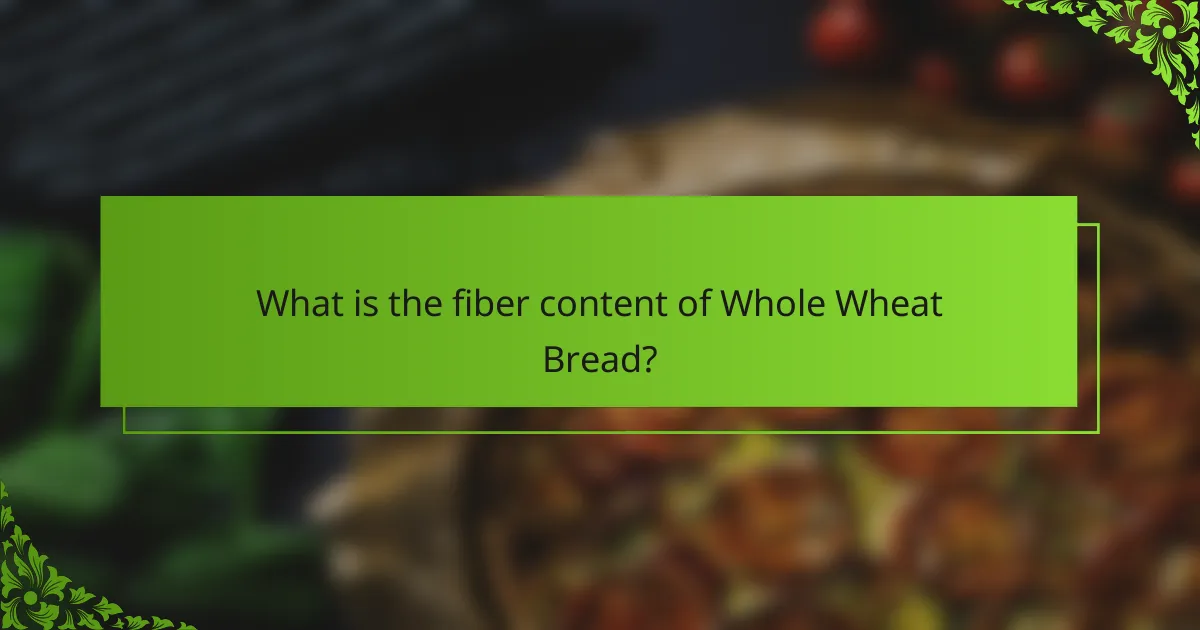Whole wheat bread is a nutritious bread made from the entire wheat kernel, including the bran, germ, and endosperm. It is known for its high dietary fiber content, typically ranging from 2 to 3 grams per slice, and is associated with various health benefits, such as improved digestion and reduced risk of chronic diseases. Whole wheat bread has a denser texture and a nuttier flavor compared to white bread, making it a flavorful choice for many. The article will explore the nutritional value of whole wheat bread, its fiber content, taste profile, and provide various recipe ideas for incorporating this healthy alternative into your diet.

What is Whole Wheat Bread?
Whole wheat bread is a type of bread made from flour that uses the entire wheat kernel. This includes the bran, germ, and endosperm, which contributes to its nutritional value. Whole wheat bread is rich in dietary fiber, vitamins, and minerals. It typically has a denser texture and a nuttier flavor compared to white bread. Studies show that whole wheat bread can aid in digestion and promote heart health. The whole grain content is linked to lower risks of chronic diseases. Whole wheat bread is often recommended as a healthier alternative to refined bread products.
How is Whole Wheat Bread made?
Whole wheat bread is made by grinding whole wheat grains into flour. The process begins with harvesting wheat, which is then cleaned and milled. During milling, the bran, germ, and endosperm are all included, preserving the grain’s nutritional value. Water, yeast, salt, and sometimes sugar are added to the flour to create dough. The dough is kneaded to develop gluten, which gives bread its structure. After kneading, the dough is allowed to rise, typically for one to two hours. This fermentation process enhances flavor and texture. Finally, the dough is shaped, placed in a baking pan, and baked in an oven until golden brown. Whole wheat bread retains more fiber and nutrients compared to white bread due to the use of the entire grain.
What ingredients are essential for making Whole Wheat Bread?
Whole wheat bread requires essential ingredients for its preparation. The primary ingredient is whole wheat flour, which provides the base. Water is necessary to hydrate the flour and activate the gluten. Yeast acts as a leavening agent, helping the bread to rise. Salt enhances flavor and strengthens the dough structure. Optional ingredients include sweeteners like honey or sugar, which can improve taste. Additionally, fats such as olive oil or butter can contribute to texture and moisture. Each ingredient plays a crucial role in the bread-making process, ensuring a nutritious and flavorful end product.
What is the baking process for Whole Wheat Bread?
The baking process for whole wheat bread involves several key steps. First, combine whole wheat flour, water, yeast, and salt. This mixture forms the dough. Next, knead the dough for about 10 minutes. Kneading develops gluten, which gives the bread structure. After kneading, let the dough rise in a warm place until it doubles in size. This usually takes about 1 to 2 hours.
Once risen, punch down the dough to release air. Shape it into a loaf and place it in a greased pan. Allow it to rise again until it reaches the top of the pan. This second rise typically takes 30 to 60 minutes.
Preheat the oven to 375°F (190°C). Bake the bread for 30 to 40 minutes. The bread is done when it sounds hollow when tapped on the bottom. Cool the bread on a wire rack before slicing. This process ensures a nutritious and flavorful whole wheat bread.
What are the nutritional components of Whole Wheat Bread?
Whole wheat bread contains essential nutritional components. It is rich in dietary fiber, which aids digestion. Whole wheat bread typically provides about 2 grams of fiber per slice. It also contains protein, averaging around 4 grams per slice. Additionally, whole wheat bread is a source of complex carbohydrates, contributing approximately 12-15 grams per slice.
Vitamins and minerals are also present in whole wheat bread. It contains B vitamins, including niacin and thiamine, which support energy metabolism. Whole wheat bread is a good source of minerals such as iron and magnesium. Iron content is approximately 0.7 mg per slice, while magnesium is around 23 mg.
Antioxidants found in whole wheat bread help combat oxidative stress. Whole wheat flour retains the bran and germ, providing more nutrients than refined flour. Overall, whole wheat bread is a nutritious choice in a balanced diet.
How does fiber content in Whole Wheat Bread compare to other breads?
Whole wheat bread generally contains more fiber than white bread and many other types of bread. Whole wheat bread typically has about 2 to 3 grams of fiber per slice. In contrast, white bread often contains less than 1 gram of fiber per slice. Some specialty breads, like oat or rye, can have comparable fiber levels. For example, a slice of rye bread may also provide around 2 grams of fiber. Whole wheat bread’s higher fiber content is due to its use of the entire wheat grain, including the bran and germ. This makes it a healthier choice for digestive health and maintaining satiety.
What vitamins and minerals are found in Whole Wheat Bread?
Whole wheat bread contains several essential vitamins and minerals. Key vitamins include B vitamins such as thiamine, niacin, and folate. These vitamins support energy metabolism and are vital for overall health. Whole wheat bread also provides minerals like iron, magnesium, and zinc. Iron is crucial for oxygen transport in the blood. Magnesium supports muscle and nerve function. Zinc is important for immune function and wound healing. The presence of these nutrients makes whole wheat bread a nutritious choice in a balanced diet.
What health benefits does Whole Wheat Bread provide?
Whole wheat bread provides numerous health benefits. It is rich in dietary fiber, which aids digestion and promotes regular bowel movements. Whole wheat bread contains essential nutrients, including vitamins B1, B3, and B5, as well as minerals like iron, magnesium, and zinc. These nutrients support energy metabolism and overall health. The fiber content in whole wheat bread can help regulate blood sugar levels, reducing the risk of type 2 diabetes. Additionally, whole wheat bread is associated with a lower risk of heart disease due to its ability to lower cholesterol levels. Studies indicate that whole grains, such as whole wheat, can contribute to weight management by promoting satiety. Overall, incorporating whole wheat bread into a balanced diet can enhance nutritional intake and support long-term health.
How does Whole Wheat Bread contribute to digestive health?
Whole wheat bread contributes to digestive health primarily through its high fiber content. Fiber aids in promoting regular bowel movements. It helps to prevent constipation by adding bulk to the stool. Whole wheat bread contains both soluble and insoluble fiber. Soluble fiber can help regulate blood sugar levels. Insoluble fiber supports the growth of beneficial gut bacteria. A study published in the Journal of Nutrition found that increased fiber intake is linked to improved digestive health. Regular consumption of whole wheat bread can therefore enhance overall gut function.
What role does Whole Wheat Bread play in weight management?
Whole wheat bread aids in weight management by providing high fiber content. Fiber promotes satiety, helping individuals feel full longer. This can reduce overall calorie intake. Whole wheat bread typically contains about 2-3 grams of fiber per slice. Studies show that high-fiber diets are linked to lower body weight. Additionally, whole grains have a lower glycemic index than refined grains. This means they cause a slower rise in blood sugar levels. Consequently, whole wheat bread can help maintain stable energy levels. This stability can support better food choices throughout the day.

What is the fiber content of Whole Wheat Bread?
Whole wheat bread typically contains about 2 to 3 grams of fiber per slice. This fiber content varies based on the brand and recipe used. Whole wheat flour retains the bran and germ, which are rich in fiber. The presence of these components contributes to the overall nutritional value of the bread. Consuming whole wheat bread can help improve digestive health due to its fiber content. Additionally, studies indicate that higher fiber intake is associated with various health benefits, including reduced risk of heart disease.
How much fiber is in a slice of Whole Wheat Bread?
A slice of whole wheat bread typically contains about 2 to 3 grams of fiber. This amount can vary based on the brand and specific recipe used. Whole wheat bread is made from whole grain flour, which retains the bran and germ. These components are rich in dietary fiber. According to the USDA, fiber is essential for digestive health. Hence, consuming whole wheat bread can contribute to daily fiber intake recommendations.
What types of fiber are present in Whole Wheat Bread?
Whole wheat bread contains both soluble and insoluble fiber. Soluble fiber helps regulate blood sugar levels and lowers cholesterol. It dissolves in water and forms a gel-like substance in the digestive tract. Insoluble fiber adds bulk to stool and aids in digestion. It does not dissolve in water and helps food pass through the digestive system. Whole wheat bread typically provides about 2 to 3 grams of fiber per slice. This fiber content contributes to overall health benefits, including improved digestive health and reduced risk of chronic diseases.
How does fiber content vary between different brands of Whole Wheat Bread?
Fiber content in whole wheat bread varies significantly among different brands. Some brands offer as little as 1 gram of fiber per slice. Others may provide up to 6 grams per slice. The variation often depends on the specific ingredients used and the manufacturing process. For example, brands that include additional whole grains or seeds typically have higher fiber content. A study by the Whole Grains Council shows that whole wheat bread with added bran has notably higher fiber levels. Additionally, nutritional labels on packaging can provide specific fiber content for each brand. Therefore, consumers should compare labels to determine the best options for their dietary needs.
Why is fiber important in our diet?
Fiber is important in our diet because it aids digestion and promotes gut health. It helps regulate bowel movements by adding bulk to stool. This can prevent constipation and other digestive issues. Fiber also contributes to a feeling of fullness, which can aid in weight management. It plays a role in lowering cholesterol levels and stabilizing blood sugar levels. Studies show that a high-fiber diet can reduce the risk of heart disease and type 2 diabetes. The recommended daily intake of fiber is about 25 grams for women and 38 grams for men. Whole grains, fruits, and vegetables are excellent sources of dietary fiber.
How does dietary fiber affect overall health?
Dietary fiber positively affects overall health by promoting digestive health and preventing constipation. It aids in regulating blood sugar levels and lowering cholesterol. High fiber intake is linked to a reduced risk of heart disease. Studies show that individuals consuming 25-30 grams of fiber daily have better weight management. Fiber-rich diets can enhance satiety, leading to reduced calorie intake. Additionally, fiber supports gut microbiota, contributing to improved immune function. Research indicates that whole grains, such as those found in whole wheat bread, are excellent sources of dietary fiber.
What are the recommended daily fiber intake levels?
The recommended daily fiber intake levels are 25 grams for [censured] women and 38 grams for [censured] men. These values are based on dietary guidelines from health organizations. Fiber intake supports digestive health and can help prevent chronic diseases. Studies indicate that most individuals do not meet these recommended levels. Increasing fiber intake can be achieved through whole grains, fruits, and vegetables. Whole wheat bread is an excellent source of dietary fiber.

What does Whole Wheat Bread taste like?
Whole wheat bread has a nutty and slightly sweet flavor. The taste is richer compared to white bread. Its texture is denser and more robust. Whole wheat bread retains the bran and germ of the wheat, enhancing its flavor profile. This bread often has a chewy consistency, contributing to its hearty feel. The presence of fiber adds to the overall mouthfeel, making it more satisfying. Whole wheat bread is also known for its earthy undertones, which can vary based on the brand and ingredients used.
How does the taste of Whole Wheat Bread compare to white bread?
Whole wheat bread has a nuttier and more robust flavor compared to white bread. This difference arises from the use of whole grains, which retain the bran and germ. White bread, made from refined flour, has a milder taste and softer texture. Whole wheat bread also tends to be denser than white bread. The flavor profile of whole wheat bread includes earthy notes, while white bread is often described as slightly sweet. Taste preferences vary among individuals, but many appreciate the heartiness of whole wheat. Studies indicate that whole grain products can enhance flavor complexity in baked goods.
What factors influence the flavor of Whole Wheat Bread?
The flavor of whole wheat bread is influenced by several factors. The type of wheat used affects the taste profile. Whole wheat flour contains the bran, germ, and endosperm, contributing to a nuttier flavor. The milling process can also impact flavor; coarser flour may yield a more robust taste. Fermentation time plays a critical role; longer fermentation can enhance flavor complexity. The addition of ingredients like honey or seeds can introduce sweetness and texture. Baking temperature and time influence crust flavor; higher temperatures create a more caramelized crust. Finally, moisture content in the dough affects overall taste and texture. Each of these factors contributes to the unique flavor of whole wheat bread.
How can the taste of Whole Wheat Bread be enhanced?
To enhance the taste of whole wheat bread, consider adding ingredients like honey, herbs, or seeds. Honey adds sweetness, balancing the nutty flavor of whole wheat. Fresh herbs, such as rosemary or thyme, can introduce aromatic notes. Seeds like sunflower or sesame provide crunch and additional flavor. Incorporating spices, such as cinnamon or nutmeg, can also elevate the taste profile. Using high-quality flour improves overall flavor. Additionally, toasting the bread can enhance its taste by bringing out its natural nuttiness. These methods have been shown to create a more enjoyable eating experience.
What are some popular ways to enjoy Whole Wheat Bread?
Whole wheat bread can be enjoyed in various popular ways. One common method is to use it for sandwiches. Whole wheat bread provides a hearty base for meats, cheeses, and vegetables. Another popular way is to toast it. Toasting enhances its nutty flavor and adds a satisfying crunch.
Additionally, whole wheat bread is often used for making French toast. This dish combines eggs and milk to create a delicious breakfast option. Whole wheat bread can also be used for making bread crumbs. These crumbs are versatile for topping casseroles or coating proteins.
Finally, whole wheat bread is great for serving with soups and salads. It complements these dishes while adding fiber and nutrients. Each of these methods showcases the versatility and health benefits of whole wheat bread.
What spreads and toppings pair well with Whole Wheat Bread?
Nut butter, such as almond or peanut butter, pairs well with whole wheat bread. These spreads provide healthy fats and protein. Avocado is another excellent topping. It adds creaminess and essential nutrients. Hummus works well too, offering a savory flavor and plant-based protein. Additionally, Greek yogurt can be used as a spread. It is rich in protein and probiotics. Fresh vegetables like tomatoes or cucumbers enhance the texture and flavor. Lastly, jams or fruit spreads can add sweetness. They complement the nutty flavor of whole wheat bread.
How can Whole Wheat Bread be used in different meals?
Whole wheat bread can be used in various meals throughout the day. For breakfast, it can be toasted and topped with avocado or nut butter. In lunch, it serves well as a base for sandwiches filled with lean proteins and vegetables. Whole wheat bread can also be used for making hearty wraps by rolling it around fillings like grilled chicken and salad. For dinner, it can accompany soups or stews, providing a nutritious side. Additionally, it can be transformed into breadcrumbs for coating proteins or as a topping for casseroles. Whole wheat bread is versatile and enhances the fiber content of meals.

What are some recipe ideas for Whole Wheat Bread?
Whole wheat bread can be made using various recipes. One idea is to mix whole wheat flour with water, yeast, and salt. Another recipe includes adding honey for sweetness and olive oil for moisture. You can also incorporate seeds like sunflower or flaxseed for added nutrition. For a hearty version, mix in oats or bran. Adding nuts, such as walnuts, can enhance flavor and texture. Additionally, using milk or yogurt can create a softer crumb. Whole wheat bread typically takes about 30 minutes to bake at 375°F. These recipes provide a nutritious alternative to white bread, rich in fiber and essential nutrients.
What are some easy recipes that include Whole Wheat Bread?
Some easy recipes that include whole wheat bread are sandwiches, toast, and bread pudding.
For sandwiches, use whole wheat bread with turkey, lettuce, and tomato. This combination offers a nutritious meal option.
Toast can be topped with avocado and poached eggs for a healthy breakfast.
Bread pudding can be made by combining whole wheat bread, eggs, milk, and sugar. This dessert is a delicious way to use leftover bread.
These recipes showcase the versatility of whole wheat bread in everyday meals.
How can Whole Wheat Bread be incorporated into breakfast dishes?
Whole wheat bread can be incorporated into breakfast dishes in various ways. It serves as a nutritious base for sandwiches. Whole wheat toast can be topped with avocado for healthy fats. It can also be used for French toast, providing a fiber-rich alternative. Whole wheat bread can be cubed for breakfast casseroles, adding texture and nutrients. Additionally, it can be blended into smoothies for added fiber. Whole wheat bread is versatile and enhances the nutritional value of breakfast meals.
What lunch recipes feature Whole Wheat Bread as a main ingredient?
Whole wheat bread is commonly used in various lunch recipes. Popular options include whole wheat sandwiches, which can be filled with lean meats, vegetables, and spreads. Another recipe is whole wheat toast topped with avocado and poached eggs. Whole wheat bread can also be used for making paninis filled with cheese and vegetables. Additionally, whole wheat bread can serve as a base for open-faced sandwiches topped with tuna or chicken salad. These recipes utilize the nutritional benefits of whole wheat bread, such as its high fiber content, making them both healthy and filling.
What tips can help in making the best Whole Wheat Bread at home?
To make the best whole wheat bread at home, use fresh, high-quality whole wheat flour. Fresh flour retains more nutrients and flavor. Measure ingredients accurately for consistent results. Use a kitchen scale for precision. Incorporate vital wheat gluten to improve texture and rise. This ingredient enhances the elasticity of the dough. Hydrate the dough adequately for optimal gluten development. A wetter dough results in a softer bread. Knead the dough thoroughly to develop gluten structure. This process takes about 10 minutes of vigorous kneading. Allow for proper fermentation by letting the dough rise until doubled in size. This usually takes 1 to 2 hours in a warm environment. Bake in a preheated oven at 350°F for even cooking. This temperature ensures the bread cooks through without burning. Let the bread cool completely before slicing for better texture. Slicing too early can result in a gummy loaf.
How can you ensure the perfect texture and rise in Whole Wheat Bread?
To ensure the perfect texture and rise in whole wheat bread, use high-quality whole wheat flour. Whole wheat flour contains more bran and germ, which can hinder gluten development. Therefore, incorporating vital wheat gluten can enhance elasticity.
Additionally, proper hydration is crucial. Whole wheat flour absorbs more water than white flour. Aim for a hydration level of around 75% for optimal results.
Kneading the dough sufficiently develops gluten structure. Knead for at least 10 minutes until smooth and elastic.
Allow the dough to rise in a warm environment. This promotes yeast activity and proper fermentation.
Finally, bake at a temperature of 375°F (190°C) to achieve a good crust and texture. These methods collectively contribute to achieving the desired texture and rise in whole wheat bread.
What common mistakes should be avoided when baking Whole Wheat Bread?
Common mistakes to avoid when baking whole wheat bread include using insufficient water. Whole wheat flour absorbs more liquid than white flour. Not allowing enough time for rising is another mistake. Whole wheat dough requires longer fermentation. Over-kneading can also be an issue. This can lead to a dense texture. Additionally, neglecting to check the freshness of yeast affects the rise. Expired yeast will not activate properly. Lastly, skipping the use of vital wheat gluten can result in a crumbly loaf. Whole wheat bread benefits from this added protein for better structure.
Whole wheat bread is a nutritious type of bread made from the entire wheat kernel, retaining its bran, germ, and endosperm. This article explores the nutritional value of whole wheat bread, highlighting its fiber content, essential vitamins, and minerals, as well as its health benefits such as improved digestion and reduced risk of chronic diseases. Additionally, it covers the baking process, key ingredients, and offers various recipe ideas for incorporating whole wheat bread into meals. The article also compares the taste and texture of whole wheat bread to white bread, emphasizing its denser and nuttier flavor profile.